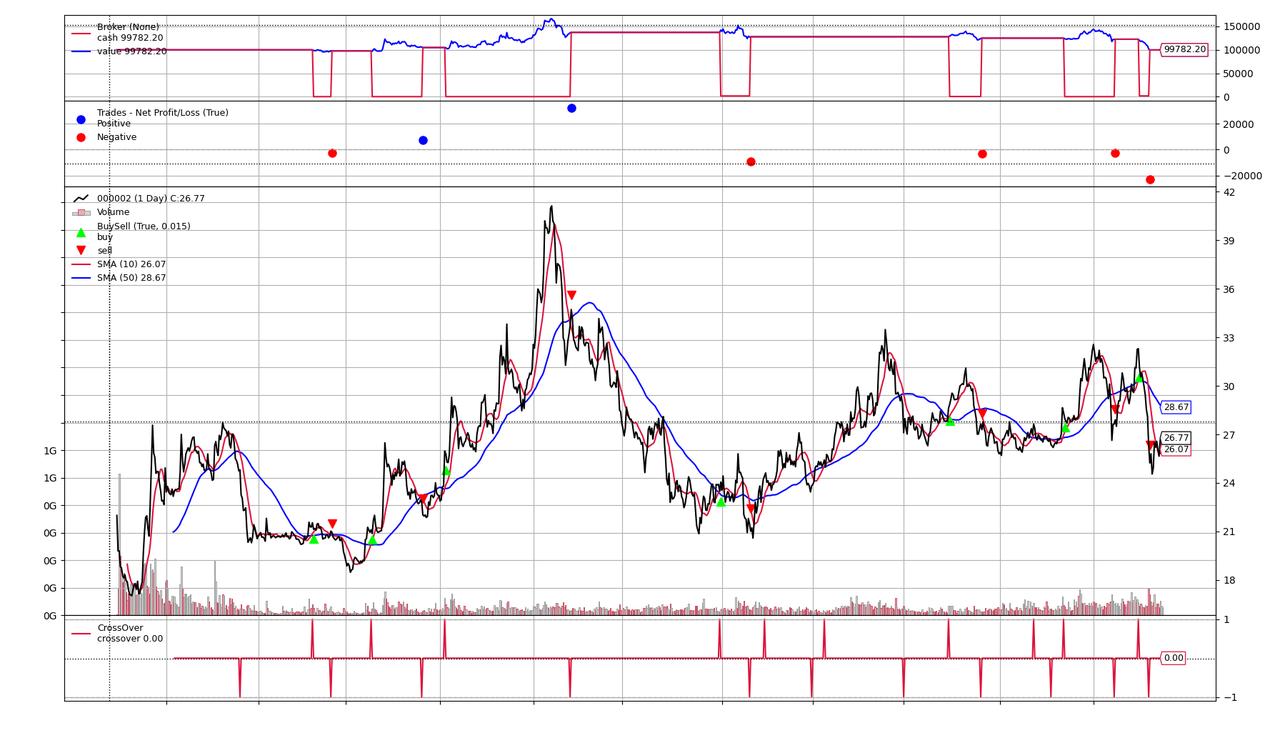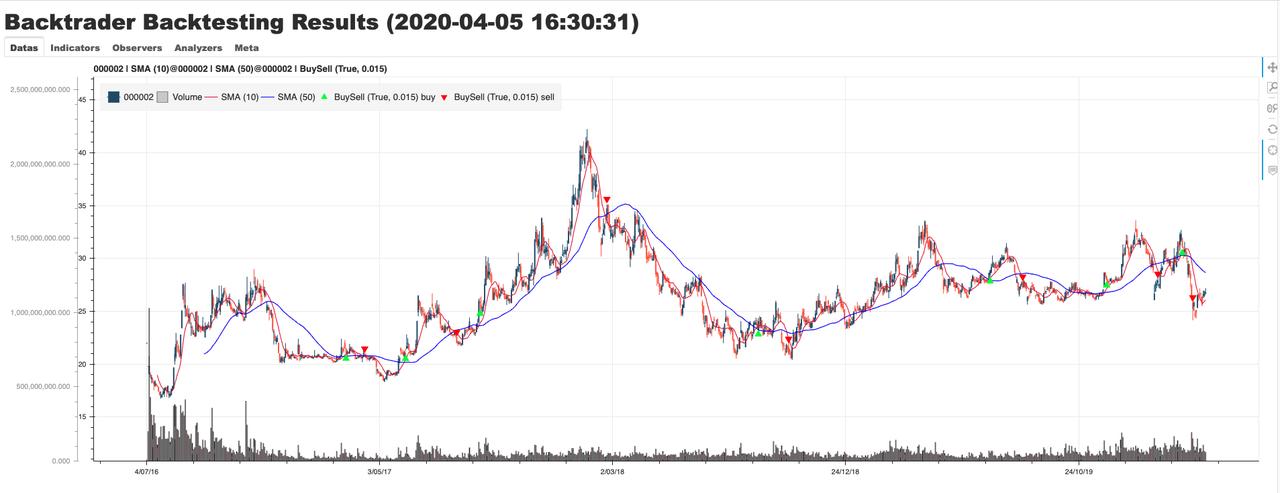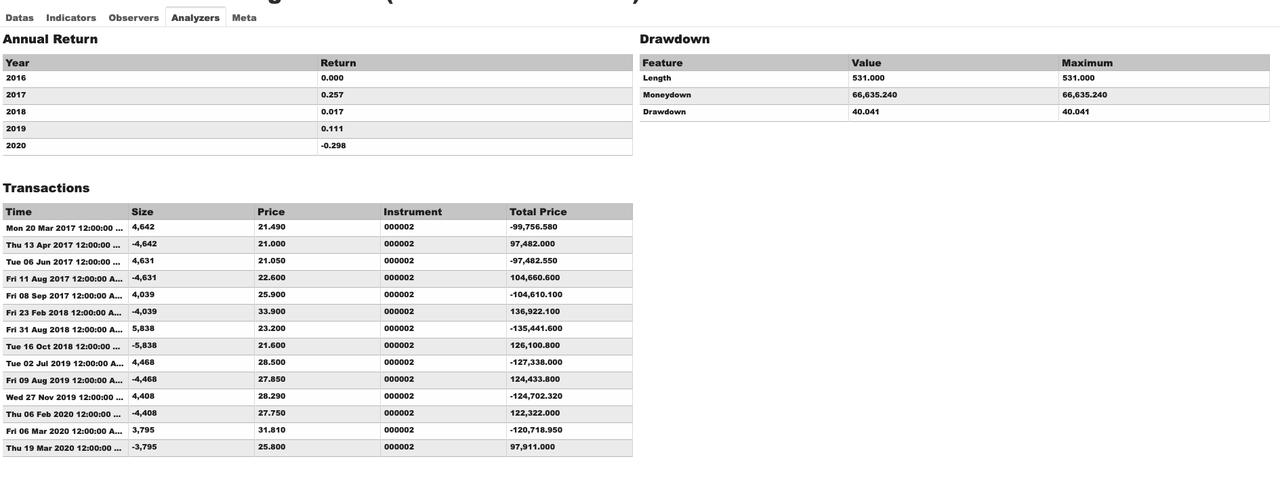量化交易的开源回测框架中, Zipline 应该是最流行的,国内也有不少模仿Zipline 的回测框架存在,甚至可以说国内开源或商业化回测平台,几乎都是模仿Zipline和Quantopian。Zipline模式似乎成了业界标杆,但是对于普通开发者入手难度并不低。数据注入(Ingest),data bundle管理异常麻烦,对比各个开源回测工具,我发现 Backtrader 非常灵活,上手难度也很低,也能满足大部分普通回测场景的需求。这篇博客,介绍我使用本地数据库,利用Backtrader进行单资产回测的经验。
均线交叉策略回测单个资产
均线交叉 是一种非常常见的交易策略,在量化和非量化交易中应用广泛。这里我选择的长周期均线是50日MA,短周期均线是10日MA,当10日均线上穿50日均线买入,10日均线下穿50日均线则卖出。回测对象是2016年1月1日到本周五(2020年4月3日)的 万科(000002) ,数据来源是本地数据库中存储的日行情表。
准备
python3, 自2020年1月,PSF已经停止维护python3以下的版本,你必须要在本地安装Python3.6或以上版本。当然也可选择安装最新版的annaconda发行版。确认安装好Python后,在命令行执行python可以进入交互式命令行环境,运行 pip 确认安装成功。
安装软件包, pip install backtrader[plotting] sqlalchemy psycopg2 安装backtrader到你的开发环境。sqlalchemy用于数据库操作,psycopg2是postgresql的Python连接驱动。
logging, 代码中使用Python标准款logging来打印日志,需要了解Python中如何 配置logging 。
使用本地数据库
相比Zipline,Backtrader可以轻易地集成任何数据格式,这里我使用Postgresql数据库中存储的日行情表作为数据源提取数据,数据格式如下表:
| date | symbol | open | high | low | close | volume |
|---|---|---|---|---|---|---|
| 2020-04-03 | 000002 | 26.75 | 27.18 | 26.60 | 26.77 | 56945280 |
| 2020-04-02 | 000002 | 26.50 | 26.94 | 26.35 | 26.88 | 663097380 |
| 2020-04-01 | 000002 | 26.45 | 26.96 | 26.25 | 26.63 | 107433164 |
参考 文档 ,编写自定义的的DataFeed,DataFeed执行SQL从本地数据库抽取日行情,策略代码将使用这个创建的DataFeed来获取数据。
下面是我们的代码
import logging
import datetime
from typing import Iterator, List, Tuple
import backtrader as bt
from sqlalchemy.engine import Engine, create_engine
log = logging.getLogger(__name__)
class DBDataFeed(bt.feed.DataBase):
symbol: str
historical_eod: Iterator
engine: Engine = None
params = (
("dataname", None),
("fromdate", datetime.date(2000, 1, 1)),
("todate", datetime.date(2050, 1, 1)),
("compression", 1),
("timeframe", bt.TimeFrame.Days),
("symbol", None),
)
def __init__(self, db_uri, *args, **kwargs):
# db_uri sqlalchemy文档:
# https://docs.sqlalchemy.org/en/13/core/engines.html
super(*args, **kwargs)
self.db_uri = db_uri
self.symbol = self.p.dataname
def start(self):
super().start()
if not self.engine:
log.info("initialize db connection: {}".format(self.db_uri))
self.__class__.engine = create_engine(self.db_uri)
# 从数据库load准备数据
sql = """
SELECT "date" AS DATETIME
, "open"
, high
, low
, "close"
, volume
FROM cn.historical_daily
WHERE symbol = '{}'
AND "open" > 0
AND high > 0
AND low > 0
AND "close" > 0
AND volume > 0
AND "date" >= %s
AND "date" <= %s
""".format(self.symbol)
rp = self.engine.execute(sql, (self.p.fromdate, self.p.todate))
historical_eod = list(rp.fetchall())
historical_eod.sort(key=lambda x: x.datetime)
self.historical_eod = iter(historical_eod)
log.info(
"load {} rows for {}".format(len(historical_eod), self.symbol)
)
def stop(self):
pass
def _load(self):
# 实现 datafeed 的iterator接口函数
try:
row = next(self.historical_eod)
except StopIteration:
return False
self.lines.datetime[0] = bt.date2num(row.datetime)
self.lines.open[0] = float(row.open)
self.lines.high[0] = float(row.high)
self.lines.low[0] = float(row.low)
self.lines.close[0] = float(row.close)
self.lines.volume[0] = float(row.volume)
self.lines.openinterest[0] = 0
return True
编写策略代码
策略代码本身很简单,但需要先了解几个概念:
Broker,Broker中文含义是经纪人,通常代指我们的券商。回测是模拟交易,需要有一个执行交易的模拟Broker,代码中没有指定Broker,默认使用 backtrader.brokers.BackBroker ,调用 broker.buy 或 broker.sell 时会使用下一个交易日的 open price 成交。
Sizer,回测过程中,如果执行买卖操作时没有指定买卖目标数量,Sizer会用于计算买卖数量。代码中使用 AllInSizerInt ,表示若没有买卖目标数量,那么执行全仓买入或卖出。
Analyzer,对回测进行分析非常重要,Backtrader提供多种分析器,代码中使用的分析器是 1)年度收益统计,2)回撤分析,3)交易记录表。
策略回测代码
import datetime
class SMACross(bt.Strategy):
params = dict(
sma_lower=10, # period for lower SMA
sma_higher=50, # period for higher SMA
)
def __init__(self):
# 10日SMA计算
sma1 = bt.ind.SMA(period=self.p.sma_lower)
# 50日SMA计算
sma2 = bt.ind.SMA(period=self.p.sma_higher)
# 均线交叉, 1是上穿,-1是下穿
self.crossover = bt.ind.CrossOver(sma1, sma2)
def next(self):
close = self.data.close[0]
date = self.data.datetime.date(0)
if not self.position:
if self.crossover > 0:
log.info("buy created at {} - {}".format(date, close))
self.buy()
elif self.crossover < 0:
log.info("sell created at {} - {}".format(date, close))
self.close()
if __name__ == "__main__":
cerebro = bt.Cerebro()
data = DBDataFeed(
# 本地postgresql数据库
db_uri="postgresql://user:password@localhost:5432/dbname",
dataname="000002",
fromdate=datetime.date(2016, 1, 1),
)
cerebro.adddata(data)
cerebro.addstrategy(SMACross)
cerebro.addsizer(bt.sizers.AllInSizerInt)
cerebro.broker.set_cash(100000)
cerebro.addanalyzer(bt.analyzers.AnnualReturn, _name="annual_returns")
cerebro.addanalyzer(bt.analyzers.DrawDown, _name="draw_down")
cerebro.addanalyzer(bt.analyzers.Transactions, _name="transactions")
results = cerebro.run()
# 打印Analyzer结果到日志
for result in results:
annual_returns = result.analyzers.annual_returns.get_analysis()
log.info("annual returns:")
for year, ret in annual_returns.items():
log.info("\t {} {}%, ".format(year, round(ret * 100, 2)))
draw_down = result.analyzers.draw_down.get_analysis()
log.info(
"drawdown={drawdown}%, moneydown={moneydown}, drawdown len={len}, "
"max.drawdown={max.drawdown}, max.moneydown={max.moneydown}, "
"max.len={max.len}".format(**draw_down)
)
transactions = result.analyzers.transactions.get_analysis()
log.info("transactions")
# 运行结果绘图
cerebro.plot()
运行Python代码
| Year | Return |
|---|---|
| 2016 | 0.0% |
| 2017 | 25.7% |
| 2018 | 1.7% |
| 2019 | 11.1% |
| 2020 | -29.8% |
策略运行结果plotting图

使用backtrader_plotting
Backtrader自带的plotting图形阅读效果和稳定性都较差,建议使用社区开发的基于web的plotting插件: backtrader_plotting 方便读图和分析。
pip install backtrader_plotting 安装插件。
修改代码,在代码文件顶部引入backtrader_plotting
from backtrader_plotting import Bokeh from backtrader_plotting.schemes import Tradimo
修改代码最后一行代码,使用backtrader_plotting替换自带默认plotting
# cerebro.plot() b = Bokeh(style="bar", tabs="multi", scheme=Tradimo()) cerebro.plot(b)
再次运行回测代码,查看效果


总结
Backtrader单资产测试的代码量少,可读性高,扩展性高。配合backtrader_plotting,应该能满足大部分开发需求。后面还要思考的是:
1)如何处理股份拆并和配送,以及现金分红
2)如何进行多资产回测
3)如何对回测数据进行更多维度的分析
4)如何对接实盘交易

This work is licensed under a Creative Commons Attribution-NonCommercial-ShareAlike 4.0 International License.